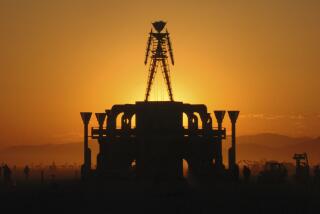Italian museum defies pope over crucified frog
- Share via
ROME — An Italian museum today defied Pope Benedict and refused to remove a modern art sculpture portraying a crucified green frog holding a beer mug and an egg that the Vatican had condemned as blasphemous.
The board of the Museion museum in the northern city of Bolzano decided by a majority vote that the frog was a work of art and would stay in place for the remainder of an exhibition.
The wooden sculpture by the late German artist Martin Kippenberger depicts a frog about 1 metre 30 cm (4 feet) high nailed to brown cross and holding a beer mug in one outstretched hand and an egg in another.
Called “Zuerst die Fuesse,” (Feet First), it wears a green loin cloth and is nailed through the hands and the feet in the manner of Jesus Christ. Its green tongue hangs out of its mouth.
Kippenberger’s works have been shown at the Tate Modern and the Saatchi Gallery in London and at the Venice Biennale, and retrospectives are planned in Los Angeles and New York.
Museum officials said the artist, who died in 1997, considered it a self-portrait illustrating human angst.
Pope Benedict, who is German himself and was recently on holiday not far from Bolzano, did not agree.
The Vatican wrote a letter of support in the pope’s name to Franz Pahl, president of the regional government who opposed the sculpture. Pahl released parts of the letter, which said the work “wounds the religious sentiments of so many people who see in the cross the symbol of God’s love”.
Pahl, whose province is heavily Catholic, was so outraged by the sculpture of the pop-eyed amphibian that he went on a hunger strike to demand its removal and had to be taken to hospital during the summer.
“Surely this is not a work of art but a blashphemy and a disgusting piece of trash that upsets many people,” Pahl told Reuters by telephone.
“This decision to keep the statue there is is totally unacceptable. It is a grave offence to our Catholic population,” he said.
Museum president Alois Lageder told Reuters the decision to keep the statue on display was made in order to “safeguard the autonomy of art institutions”.
The board vote was 6-3 in favour. Art experts defended the work.
“Art must always be free and the artist should not have any restrictions on freedom of expression,” Claudio Strinati, a superindendent for Rome’s state museums, told an Italian newspaper on Thursday.
But Italy’s culture minister, Sandro Bondi, said museums that recieve state funds should not “exalt artworks of desecration, of useless provocation and of nonsense”.
More to Read
The biggest entertainment stories
Get our big stories about Hollywood, film, television, music, arts, culture and more right in your inbox as soon as they publish.
You may occasionally receive promotional content from the Los Angeles Times.










